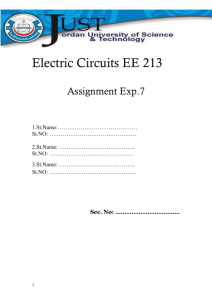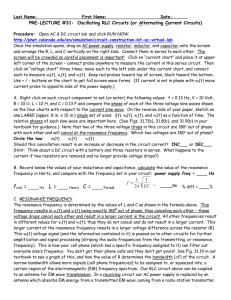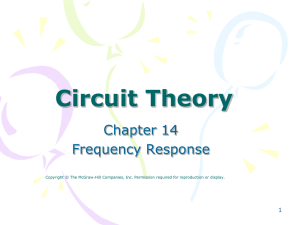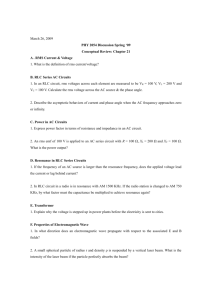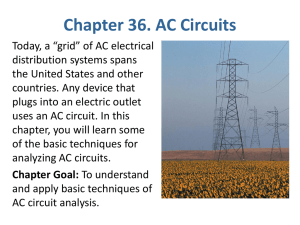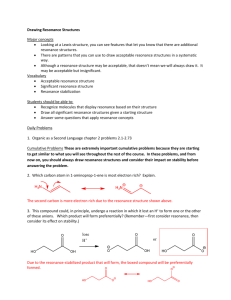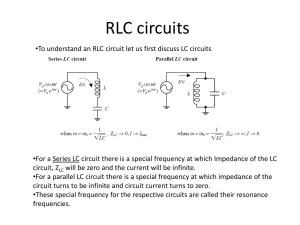parallel resonance
advertisement
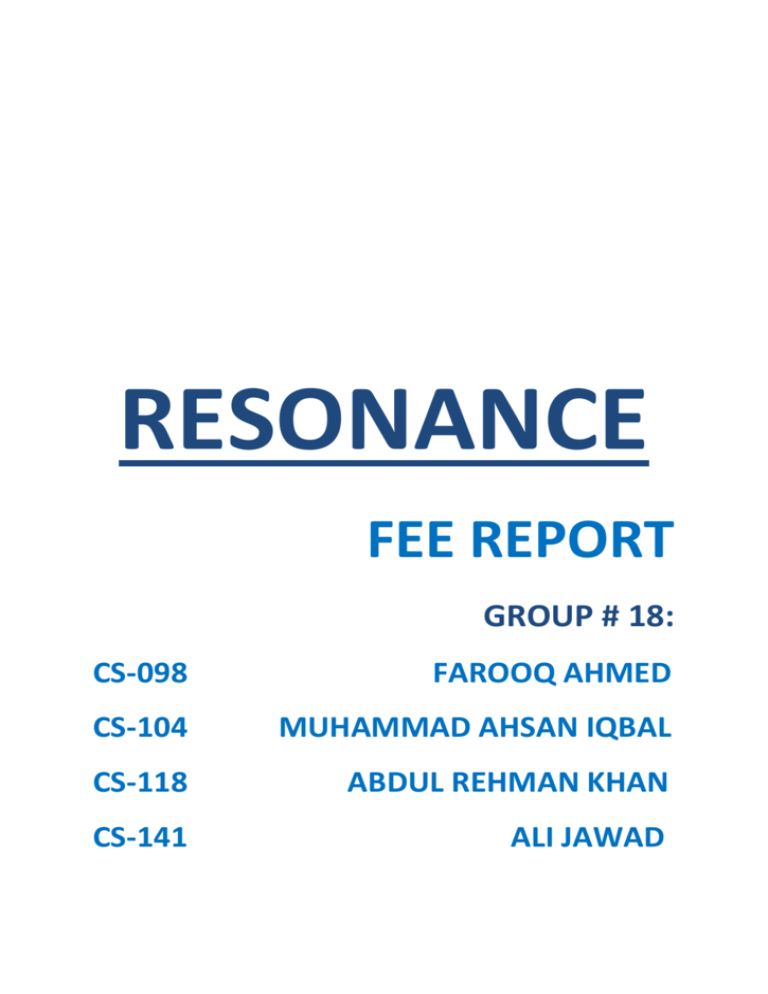
RESONANCE FEE REPORT GROUP # 18: CS-098 FAROOQ AHMED CS-104 MUHAMMAD AHSAN IQBAL CS-118 ABDUL REHMAN KHAN CS-141 ALI JAWAD RESONANCE INTRODUCTION: Resonance is the name given to a phenomenon when an object shows maximum response when it is subjected to a certain frequency known as ‘resonant frequency’ or ‘natural frequency’ of that object. Resonance can be both mechanical and electrical. Mechanical resonance can be observed in any vibrating body such as tuning fork. However resonance in electrical circuits is observed in RLC circuits. RESONANCE IN RLC CIRCUITS: The resonant circuit is a combination of R, L, and C elements having a frequency response characteristic similar to the one appearing in given figure. Resonance curve Note in the figure that the response is a maximum for the frequency fr, decreasing to the right and left of this frequency. In other words, for a particular range of frequencies the response will be near or equal to the maximum. CONDITION FOR RESONANCE: The required condition for resonance is that circuit’s capacitive reactance becomes equal to its inductive reactance. XL=XC TYPES OF RESONANCE: There are two types of resonance based on how inductor and capacitor are connected in the circuit: I. II. Series Resonance Parallel Resonance 1|Page SERIES RESONANCE: Resonance in series circuits occur when the total reactance of the circuit becomes zero i.e. inductive and capacitive reactance have equal value and they cancel each other as they have a phase difference of 180⁰. MINIMUM IMPEDANCE: Since circuit elements are in series total impedance is given by: ZT=ZR + ZL + ZC ZT=R + jωL + 1 jωC ZT=R + jXL - jXc ZT=R + j(XL - Xc) Since XL=XC ZT=R This is the minimum impedance of resonant circuit. Phasor relationship of total impedance is given by the phasor diagram given below. 2|Page MAXIMUM CURRENT: At resonant frequency RLC circuit shows maximum response of current. Using Ohm’s law: V=ZI 𝑉 I=𝑍 This show that current is inversely proportional to the impedance of the circuit. In the resonance state impedance is minimum so current would be maximum. RESONANT FREQUENCY: The resonant frequency can be determined in terms of the inductance and capacitance by examining the defining equation for resonance. XL=XC ωL = 1 ωC 1 ω2=𝐿𝐶 ω= 1 √𝐿𝐶 𝟏 fr=𝟐𝝅√𝑳𝑪 UNIT POWER FACTOR: The average power to the resistor at resonance is equal to I2R, and the reactive power to the capacitor and inductor are I2XC and I2XL respectively. The power triangle shows that the total apparent power of the circuit is equal to power dissipated due to resistor. Power triangle for series resonant circuit at resonance 3|Page The power factor for circuit at resonance is: 𝑃 Fp= cos θ = 𝑆 Since P=S Fp=1 PARALLEL RESONANCE: Resonance in parallel circuits occurs when the parallel impedance is maximum. The current is in phase with the voltage during parallel resonance. The circuit resonates at a frequency which makes the inductive reactance XL and the capacitive reactance XC equal, so the two branch currents i.e. through inductor and through capacitor are equal but opposite in direction. Hence they cancel out the effect of each other and as a result the net current drawn from the source is zero. In actual practice the current is not exactly zero but has a minimum value due to small resistance of the coil. MAXIMUM IMPEDANCE: Since circuit is in parallel its admittance is given by: Y=YR+YL+YC 1 1 1 Y=𝑅 + 𝑗𝑋 + −𝑗𝑋 𝐿 1 𝑅 1 𝑋𝐶 Y= + 𝑗( 𝐶 − 1 ) 𝑋𝐿 Since XL=XC 1 1 = 𝑋𝐿 𝑋𝐶 1 Y=𝑅 This shows that in parallel resonance circuits minimum admittance is observed. impedance is maximum. 4|Page So MINIMUM CURRENT: At resonant frequency parallel RLC circuit shows minimum current. Using Ohm’s law: V=ZI 𝑉 I=𝑍 This show that current is inversely proportional to the impedance of the circuit. In parallel circuits IMPEDANCE is maximum so current would be minimum at resonance state. RESONANT FREQUENCY: In parallel circuits resonant frequency is same as series circuits i.e. ω= 1 √𝐿𝐶 𝟏 fr=𝟐𝝅√𝑳𝑪 EXPLANATION OF RESONANCE PHENOMENON IN PARALLEL CIRCUITS: At resonance, the branch currents IC and IL each may be larger than the source current. The reason is that the current impedance is high, the overall current is zero but the voltage developed across the parallel circuit is high. The individual currents developed in the inductance IL and capacitance IC at resonance can be very large but are out of phase with each other resulting in very low combined current. V=IZ 𝑉 Z=CR V= 𝐼𝐿 CR IC= 𝑉 XC 𝐼𝐿 IC= (CR) (𝜔𝐶)= Lω >1 𝑅 ILω 𝑅 => IC> I, since IC=IL => IL> I 5|Page UNIT POWER FACTOR: The average power to the resistor at resonance is equal to I2R, and the reactive power to the capacitor and inductor are I2XC and I2XL respectively. The power triangle shows that the total apparent power of the circuit is equal to power dissipated due to resistor. Power triangle for parallel resonant circuit at resonance The power factor for circuit at resonance is: 𝑃 Fp= cos θ = 𝑆 Since P=S Fp=1 Reference: Basic Electronics (ninth edition) - DROB/SCHULTZ Introductory Circuit Analysis (tenth edition) - Robert L. Boylestad 6|Page
